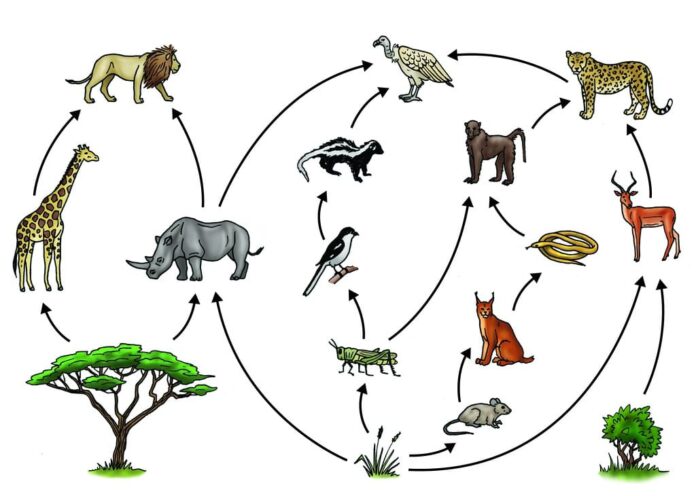Introduction to the food chain
Welcome to the fascinating world of the food chain! Have you ever wondered how every living organism is interconnected through a complex web of feeding relationships? The food chain is like nature’s own intricate puzzle, where each piece plays a vital role in maintaining balance and harmony. Join me on this journey as we unravel the mysteries of the food chain, from its basic principles to real-life examples that showcase its importance in our ecosystem. Let’s dive in and explore the wonders of this essential concept together!
How does the food chain work?
Ever wonder how the food chain keeps nature in perfect balance? It’s like a well-choreographed dance where every participant has a vital role to play. Starting at the bottom are the producers, like plants and algae, that harness energy from the sun through photosynthesis. They form the base of the food chain by converting sunlight into nutrients.
Next up are the primary consumers, herbivores that feed on plants for sustenance. These herbivores become prey for secondary consumers, carnivores who enjoy a diet rich in herbivores. At each step of this process, energy is transferred from one organism to another.
We have decomposers that break down dead organisms and waste materials back into nutrients for producers to use again. This cycle ensures that nothing goes to waste in nature’s grand design. So next time you enjoy your favorite meal, remember it’s all part of this intricate web of life called the food chain.
Types of organisms in the food chain
In the intricate web of the food chain, various organisms play vital roles in maintaining balance and sustaining life.
At the base are producers like plants, responsible for converting sunlight into energy through photosynthesis. They form the foundation of all food chains by providing nourishment to other organisms.
Moving up, primary consumers such as herbivores feed on these producers. They serve as a crucial link between plants and higher-level consumers by transferring energy up the chain.
Next come secondary consumers, which are carnivores that prey on herbivores. Their role is essential in regulating population sizes within ecosystems and ensuring ecological stability.
There are tertiary consumers at the top of the food chain, feeding on secondary consumers. These apex predators help control lower-level populations and maintain biodiversity in their habitats.
The importance of maintaining a balanced food chain
Maintaining a balanced food chain is crucial for the overall health and stability of ecosystems. Each organism plays a specific role in the chain, ensuring that energy flows efficiently from one level to another.
When any part of the food chain is disrupted or imbalanced, it can have cascading effects on other organisms and the environment as a whole. This delicate balance ensures that populations are kept in check, preventing overpopulation of certain species.
A healthy food chain also promotes biodiversity by supporting a wide range of plants and animals within an ecosystem. This diversity enhances resilience against environmental changes and helps maintain stability.
By preserving the balance in the food chain, we can protect endangered species, prevent habitat degradation, and ultimately safeguard our planet’s natural resources for future generations. It’s essential to recognize the interconnectedness of all living organisms and strive to maintain harmony within these complex relationships.
Human impact on the food chain
Human activities have a significant impact on the delicate balance of the food chain. Pollution from industries and agriculture seeps into water bodies, affecting aquatic plants and animals at the base of the food chain. Overfishing disrupts marine ecosystems, leading to imbalances in predator-prey relationships. Deforestation destroys habitats for many species, causing ripple effects throughout the entire food web.
The use of pesticides in farming can harm not only pests but also beneficial insects that are essential for pollination. Climate change alters natural habitats and migration patterns, forcing species to adapt or face extinction. Introducing invasive species can outcompete native organisms for resources, further destabilizing the food chain.
It is crucial for us to recognize our role in these disruptions and take steps towards sustainable practices to protect biodiversity and ensure a healthy food chain for future generations.
Examples of real-life food chains
Imagine a lush forest ecosystem where the food chain comes to life in its most intricate form. Here, sunlight is absorbed by plants, kickstarting the chain as they are eaten by herbivores like deer. The deer then become prey for carnivores such as wolves, completing the cycle of energy transfer.
In the depths of the ocean, another fascinating food chain unfolds. Tiny phytoplankton serve as the base, consumed by small fish that are then hunted by larger predators like sharks. This underwater web demonstrates how every organism plays a crucial role in sustaining life beneath the waves.
Even in urban settings, food chains exist within our backyard bird feeders. Birds feast on seeds left out for them, while also preying on insects like caterpillars. These interconnected relationships remind us that no matter where we look, nature’s balance through food chains is always at play.
Conclusion: Understanding and preserving the delicate balance of the food chain
Understanding and preserving the delicate balance of the food chain is crucial for the health of ecosystems worldwide. By recognizing how different organisms depend on each other for survival, we can appreciate the intricate web of life that sustains our planet.
As humans, it is our responsibility to ensure that our actions do not disrupt this delicate balance. From overfishing in oceans to deforestation on land, human activities have a significant impact on food chains around the world. By being mindful of our consumption habits and minimizing waste, we can help protect biodiversity and ensure a sustainable future for generations to come.
Let’s work together to safeguard the food chain and maintain harmony in nature – because ultimately, we are all interconnected in this complex system of life.
